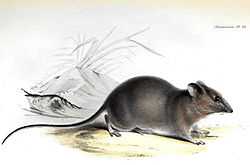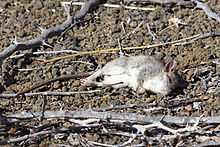Aegialomys galapagoensis
| Aegialomys galapagoensis | |
|---|---|
 | |
| The extinct A. galapagoensis galapagoensis | |
| Conservation status | |
| Scientific classification | |
| Kingdom: | Animalia |
| Phylum: | Chordata |
| Class: | Mammalia |
| Order: | Rodentia |
| Family: | Cricetidae |
| Genus: | Aegialomys |
| Species: | A. galapagoensis |
| Binomial name | |
| Aegialomys galapagoensis (Waterhouse, 1839) | |
| Synonyms | |
|
Oryzomys bauri | |
Aegialomys galapagoensis, also known as the Galápagos rice rat[1] or Galápagos oryzomys,[2] is a species of rodent in the family Cricetidae from the Galápagos Islands.

It belongs to the genus Aegialomys in tribe Oryzomyini, but was previously placed in Oryzomys as Oryzomys galapagoensis. Its natural habitat is subtropical or tropical dry shrubland.[1] Like many of the animals of the Galápagos, it is tame and unafraid of humans. Scientists working on Santa Fé Island and Fernandina Island have reported that it is necessary to keep tents open to prevent these rice rats from chewing in during the night.[3] The subspecies A. g. bauri from Santa Fé Island is sometimes considered to represent a full species. A. g. galapagoensis was formerly found on San Cristóbal Island, where Charles Darwin captured several live specimens on the second voyage of HMS Beagle in 1855. However, it is believed that it became extinct only decades after Darwin's visit, and the next specimens collected were subfossil remains found in lava tubes by David Steadman and colleagues in 1984.[4] Its closest relative is Aegialomys xanthaeolus, the only other species in the genus, which is found in coastal Ecuador and Peru.[5]
This species is listed as Vulnerable due to a very small or restricted population with only one remaining location, which is threatened by the possibility of the introduction of exotic species to the island. The species is not currently in decline, however, the only other population of was extirpated from a neighboring island due to exotic species introductions - thus this species is susceptible to extinction in the future should invasive species be introduced.
History:
2002 – Vulnerable
1996 – Critically Endangered
Geographic Range [top]
Range Description: This species is endemic to the Galápagos Islands. It occurs only on Sante Fe (= Barrington) Island, and previously occurred on San Cristobal (= Chatham) Island (Musser and Carleton, 2005). A. galapagoensis was first described from specimens collected from Santa Cruz Island by Charles Darwin in 1835. Later studies suggested that A. bauri from Santa Fe, and A. galapagoensis were so similar that they may be considered conspecific (Patton and Hafner, 1983).
References
Literature cited
- Musser, G.G. and Carleton, M.D. 2005. Superfamily Muroidea. Pp. 894–1531 in Wilson, D.E. and Reeder, D.M. (eds.). Mammal Species of the World: a taxonomic and geographic reference. 3rd ed. Baltimore: The Johns Hopkins University Press, 2 vols., 2142 pp. ISBN 978-0-8018-8221-0
- Tirira, D., Boada, C. and Weksler, M. 2008. Aegialomys galapagoensis. In IUCN. IUCN Red List of Threatened Species. Version 2009.2. <www.iucnredlist.org>. Downloaded on December 3, 2009.
- Steadman, David W., Zousmer, Steven, Steadman, Lee M. 1988. Galápagos: Discovery on Darwin's Islands Washington: Smithsonian Institution Press ISBN 0-87474-882-8
- Weksler, M., Percequillo, A.R. and Voss, R.S. 2006. Ten new genera of oryzomyine rodents (Cricetidae: Sigmodontinae). American Museum Novitates 3537:1–29.
| ||||||||||||||||||||||||||||||||||||||||||||||||||||||||||||||||||||||||||||||||||||||||||||||||||||||||||||||||||||||||||||||||||||||||||||||||||||||||
